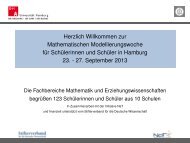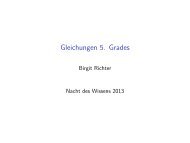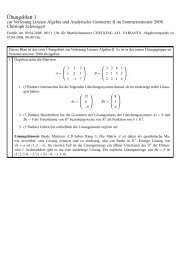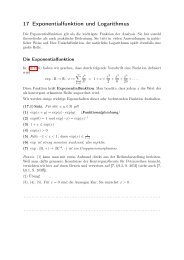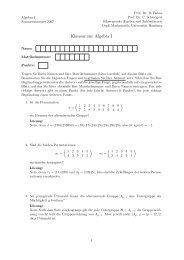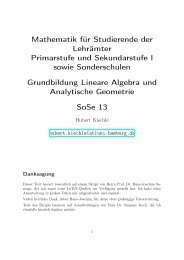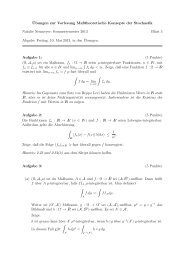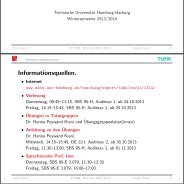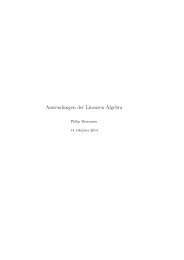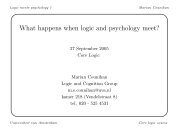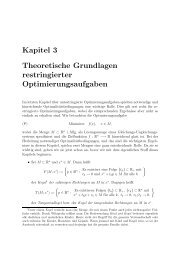pdf file
pdf file
pdf file
You also want an ePaper? Increase the reach of your titles
YUMPU automatically turns print PDFs into web optimized ePapers that Google loves.
i.e. the following diagram commutes:<br />
B <br />
φ<br />
B ′<br />
φ B<br />
M ∐ φ ′ B<br />
N<br />
(c) For any object M ∈ Cob(n), the identity map is represented by the product bordism<br />
B = M × [0, 1], i.e. the so-called cylinder over M.<br />
(d) Composition of morphisms in Cob(n) is given by gluing bordisms together.: given<br />
objects M, M ′ , M ′′ ∈ Cob(n), and bordisms B : M → M ′ and B ′ : M ′ → M ′′ , the<br />
composition is defined to be the morphism represented by the manifold B ∐ M ′ B ′ .<br />
(To get a smooth structure on this manifold, choices like collars are necessary. They<br />
lead to diffeomorphic glued bordisms, however.)<br />
2. For each n, the category Cob(n) can be endowed with the structure of a tensor category.<br />
The tensor product<br />
⊗ : Cob(n) × Cob(n) → Cob(n)<br />
is given by disjoint union. The unit object of Cob(n) is the empty set, regarded as a<br />
smooth manifold of dimension n − 1.<br />
Example 2.5.16.<br />
The objects of Cob(1) are finitely many oriented points. Thus objects are finite unions of ( •, +)<br />
and (•, −).<br />
The morphisms are oriented one-dimensional manifolds, possibly with boundary, i.e. unions<br />
of intervals and circles.<br />
An isomorphism class of objects is characterized by the numbers (n + , n − ) of points with<br />
positive and negative orientation. Sometimes, one also considers another equivalence relation<br />
on objects: two d − 1-dimensional closed manifolds M and N are called cobordant, if there is<br />
a cobordism B : N → N. Since there is a cobordism (•, +) ∐ (•, −) → ∅, the objects (n + , n − )<br />
and (n ′ +, n ′ −) are cobordant, if and only if n + − n − = n ′ + − n ′ −.<br />
One can also define a category of unoriented cobordisms. In this case, simple objects are<br />
disjoint unions of points, isomorphism classes are in bijection to the number of points. Since a<br />
pair of points can annihilate, there are only two cobordism classes, depending on whether the<br />
number of points is odd or even.<br />
Observation 2.5.17.<br />
Let M be a closed oriented n − 1-dimensional manifold. Then the oriented n-dimensional<br />
manifold B := M × [0, 1], the cylinder over M, has boundary M ∐ M. The manifold B can be<br />
considered as a cobordism in six different ways, corresponding to decomposition of its boundary:<br />
• As a bordism M → M. This represents the identity on M.<br />
• As a bordism M → M. This represents the identity on M.<br />
• As a morphism d M : M ∐ M → ∅ or, alternatively, as a morphism ˜d M : M ∐ M → ∅.<br />
• As a morphism ˜b M : ∅ → M ∐ M or, alternatively, as a morphism b M : ∅ → M ∐ M.<br />
One checks that the axioms of a left and a right duality hold. We conclude that the category<br />
Cob(n) is rigid.<br />
42




